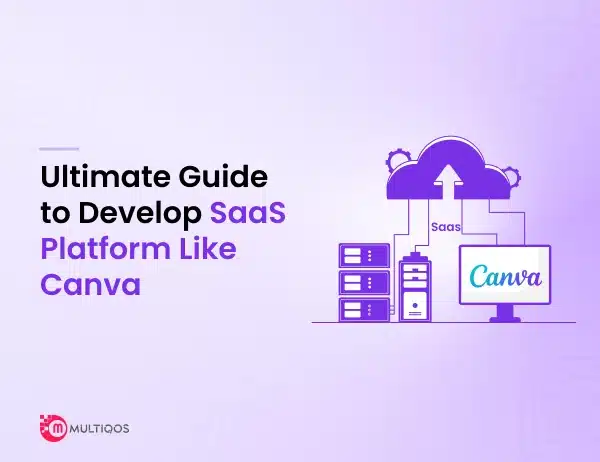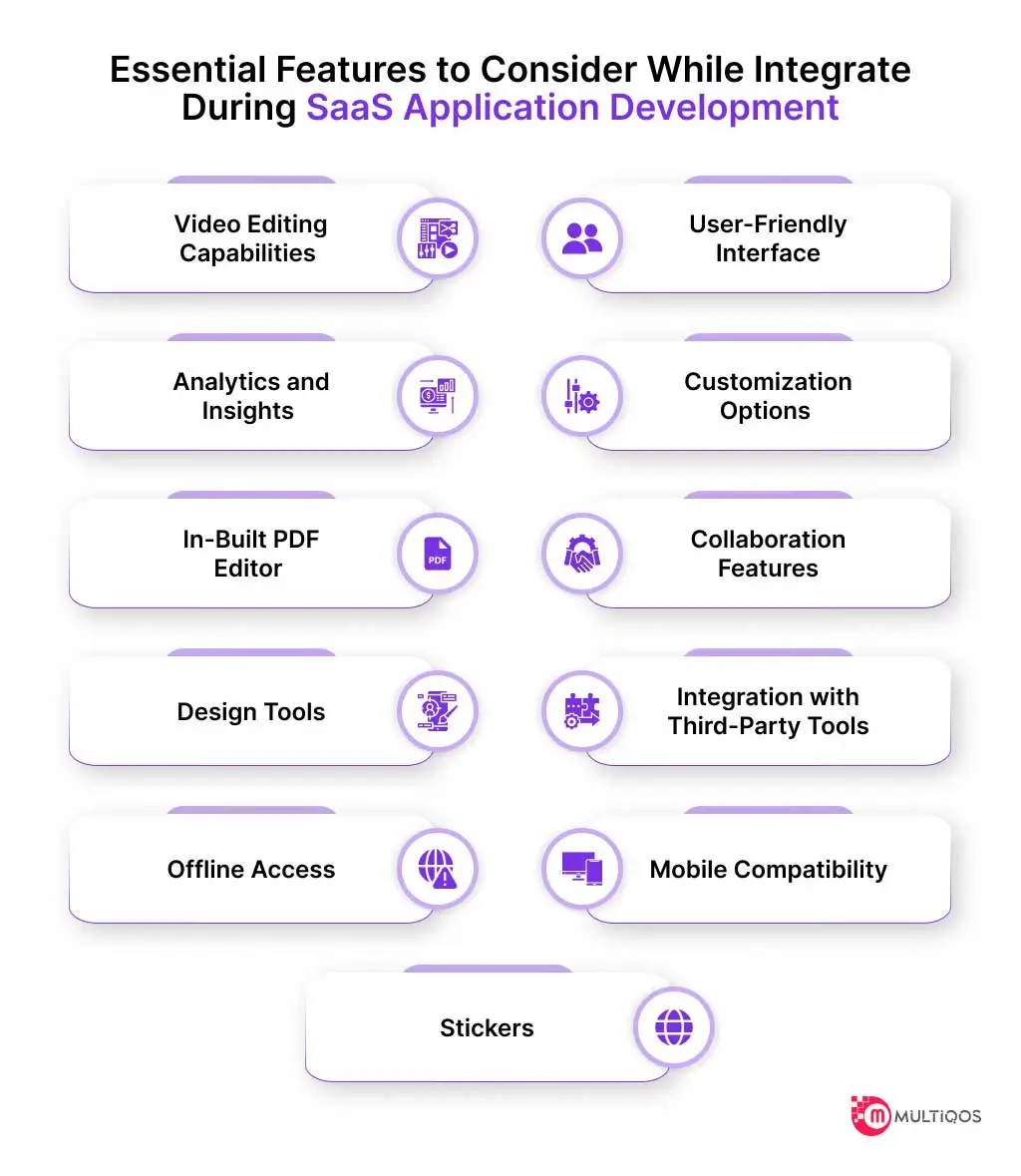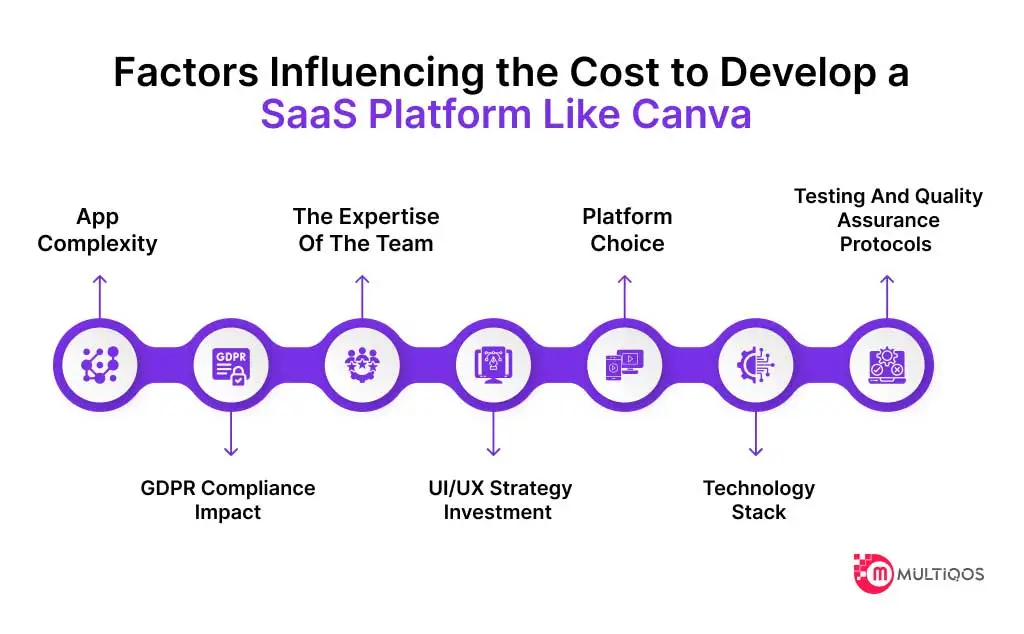Ultimate Guide to Develop Saas platform Like Canva: Costs and Development Strategies

In recent days, we have been observing that the usage of SaaS design platforms like Canva increased rapidly due to the advent of remote work and digital content creation.
These platforms have proved to be necessary instruments as not only do they provide aesthetically pleasing content but also aid their user in other professional things like presentations and graphic design.
This is one of the reasons that to hire dedicated developers who can create applications that are easy to use and understand are so much sought after. Multiple designers today accurately use applications such as Canva to immediately produce designs so that they can meet deadlines.
Based on a Statista study, the SaaS market has been experiencing massive growth, with revenue reaching four times in the period from 2016 to 2024 and there are further expectations that it will reach $374.50 billion by 2028.
Driven by the pervasiveness of cloud solutions, the growing popularity of user-friendly interfaces, and the rising demand for efficient digital collaboration tools, this growth is enabled.
This guide will take you through a step-by-step review of creating a SaaS platform just like Canva. We will unpack the development process and explore different SaaS models, detailing the key features as well as possible costs associated with the development of a Canva-like SaaS platform.
However, before moving on to the mechanism, we will analyze what reasons account for the popularity of Canva.
Why Is Canva So Popular?
Canva has become immensely popular as an easy-to-use design tool for creating social media graphics, presentations, posters, and more. One of the biggest reasons behind Canva’s success is its intuitive and user-friendly interface. Even non-designers can quickly learn to use Canva and create professional-looking designs.
The app claims to have over 1 million users across the globe to create, collaborate, and brainstorm new mobile app ideas and create a lively community where innovation thrives.
They develop profits from several channels such as subscriptions for premium features, design asset marketplace, and print-on-demand services. According to Forbes, in 2022, the company had a $40 billion valuation, and entered this $1.7 billion market, competing against the dominant players.
As Canvas’s income increases, companies should pay attention to the rising software as a service market and think over the possibility of using the trend to their advantage. When they launch a SaaS platform like Canva, they will be able to optimize their processes, increase productivity, and keep current in today’s digital scene.
How to Build a SaaS Platform Like Canva?
Building a Software as a Service (SaaS) platform akin to Canva demands meticulous planning, precise execution, and a commitment to ongoing enhancement. Understanding the financial implications is vital for effective resource management. Here are the essential steps to construct a thriving SaaS platform:
Understanding the Market and Generating Ideas
The initial processes involved in idea generation and market research are indeed factors in a brand’s image. It’s all about doing research that includes competitors, the target market, and their preferences within a given target industry.
In the market research stage, the companies invest their time and resources to identify product havens and empty places, which helps with the successful development of the conceptualization phase.
Conceptualizing and Planning the Platform
Then the process of formulating and scheming for any business or company begins. In this stage, the founders tackle the platform’s vision and mission, and goals and objectives are described as well.
In addition, here the founders emphasize the project’s scope, feature set, development timeline, and feasible budget. Collaboration with main players is imperative to invoke a strategic route map that would serve as a prompt for implementation.
Crafting User Experience (UX) and User Interface (UI)
UX and UI design stand on their own feet. These two capabilities have a great impact on both the quantity of engagements and satisfaction of a user.
Businesses may put heavy emphasis on the development of an intuitive, appealing, and user-oriented design for their SaaS platform since its success highly depends on this.
Utilizing the UI UX designer team to sharpen their skills through user research and market data knowledge, solutions are crafted that include smooth and accessible designs that follow an elegant visual appeal.
Creating Prototypes and Wireframes
Prototyping and wireframing activities are the important steps that help convert presumed designs into verisimilar interactive prototypes.
Prototypes are the crucial medium that allows to demonstrate and provide the platform’s layout, flow, and functionality visualization, accelerating stakeholder understanding and giving the room for comments and opinion incorporation.
Developing the Minimum Viable Product (MVP)
It is affordable and gives the opportunity to businesses to verify key assumptions, where they can, and also obtain the user experience, allowing them to know what works and what does not in the market.
By putting first the MVPs that cater to the real users’ necessities and agony, the companies can make the process of releasing new items faster, and on the other hand, they can avoid the situation when the resources are over linked to one or two products.
Conducting Testing and Quality Assurance
Allocating enough time and resources for testing and quality assurance (QA) activity is vital to enhance the system’s stability, reliability, or functionality.
Comprehensive testing techniques assist with the identification and elimination of any sort of bugs, errors, or inconsistencies in a platform’s codebase and functionality.
Deploying and Launching the Platform
The achievement of deployment and launch of the SaaS platform in a production environment is a major step towards the completion of the journey of development.
A launch strategy that goes as planned and well can act as a catalyst, draw early adopters on board as well as provide a sound foundation for future expansion and achievement.
Iteratively Developing and Incorporating Feedback
Using an iterative method of software development enables businesses to constantly repurpose and improve their product while taking into consideration ongoing user feedback and emerging market trends.
By involving the stakeholders and end-users in a two-way communication system through regular feedback loops, companies can track areas for improvements and adapt the business to changing market dynamics promptly.
Planning for Scalability and Setting up Infrastructure
An active approach to scale planning and resilience is needed for infrastructure and architecture since it is meant to accommodate the increasing number of users and the dynamic nature of the business requirements.
Utilizing cloud technology and architecture models that are scalable, businesses can provide SaaS platforms that are ready for the future and can grow in response to changes in use or condition.
When considering these factors, the costs associated with the building of a SaaS platform such as Canva could be reasonably estimated, which would enable the businesses to strategically allocate their endowments and consequently launch a winning and unique product.
Essential Features to Consider While Integrate During SaaS Application Development
SaaS software development requires the addition of necessary features to ensure the system is reliable and users are satisfied. Let’s explore!
Video Editing Capabilities
Allowing users to edit and customize videos right within the app will bring more benefits. Features like trimming, filters, text overlays, animations, and others can be used by the creators to make their videos look professional without much hassle.
User-Friendly Interface
The design of the interface should be intuitive enough for non-designers to easily manage. By using drag-and-drop features, simple menus, and natural workflows, users can complete tasks very easily.
Analytics and Insights
These data metrics help to tell a better story of how users engage with an asset and show where in the process a product or service can be optimized to make it convenient for customers.
These data show us how many people view, share, comment on, and download the contents which help us arrange for a better strategy in content.
Customization Options
People will expect they can fully tailor designs to fit their brand and requirements. Not only are you able to customize colors, fonts, layouts, and other elements, but you also have the freedom to create anything that comes into your mind.
In-Built PDF Editor
An integrated PDF editor gives users the ability to modify and design PDF files without having to add another program. These tools include: adding or removing pages, inserting images and shapes, highlighting and annotating, filling out forms, and adding digital signatures.
Collaboration Features
In-built collaboration tools allow simultaneous work with colleagues and clients. Commenting, task management, version history, and sharing functions are favorite features for efficient group work.
Design Tools
With a wide variety of templates, photos, illustrations, fonts, colors, and design assets, users will be able to create professional designs. High-end functions such as image masking, transparency, animation, and layering are tools that can make a project go beyond its original scope.
Integration with Third-Party Tools
Using such widely-spread-outs apps as Dropbox, Google Drive, Slack, and email providers as integrations will allow us to improve the entire process. Any data import or export of files in different formats should be one of the prime features.
Offline Access
It is crucial that the users can work offline and their changes are synced when the connection is restored for the service to be reliable. They will stay connected as long as the network is available as the service is considered up-to-date.
This, therefore, enables unbroken use in remote areas where Internet access is not stable.
Mobile Compatibility
The selected platform first needs to be optimized for mobile devices and it needs to be functional on smartphones and tablets. The tool will be able to learn from different modalities as it is used by the users. It would allow users to design anything and anywhere because of the seamless experience.
Stickers
Elevate your designs and push your creativity forward with a huge selection of ready-to-use stickers that allow you to add these unique elements with just a click. Design a SaaS app that has stickers as one of the key features thereby improving user experience and allowing for creative self-expression.
Moreover, it assists in communicating messages sturdily, improving brand communication and storytelling.
How to Monetize a SaaS Platform Like Canva?
Specific revenue channels include a paid subscription plan for all of its advanced features, business solutions as an enterprise, and the option to buy printed products and merchandise through the platform. We’re going to provide you with several techniques through which you can put innovation and better customer experience into action by developing a Canva-like app for your business. Let’s explore!
Advertising and Sponsorship
Banner ads, pop ups, and other displays can be placed on our platform to generate revenues. Purposeful ads based on the particular demographics and behavior of the user are best to get extra income.
Sponsorships a brand could pay for featuring articles, tutorials, webinars, or other co branded collaborations. This helps the customers as well as the marketing strategy of the company.
Valuable user info, as well as wrestling with usage analytics, can be packaged and sent to third parties to get their license. Data on tendencies in graphic designs, color palettes, fonts, etc. can create a unique advantage for a brand.
Likewise, analytics dashboards and application program interfaces can be monetized by providing access to other companies.
A white-labeled counterpart of the platform can be bought by other enterprises for leveraging as they own branded design solutions.
Companies may buy some specific themes, logos, and color schemes to make the platform match their brand.
Subscription Model
Set a monthly/yearly subscription fee that lets users avail of all the services/features offered by the platform. Provide planning at a lower rate for squads and small businesses.
Freemium Model
Standard and an advanced version that is subscription-based is the platform. Through word-of-mouth advertising, we can gain users and monetize our premium features.
Print Service
Customers foot the bill for the printed ones that they will order using their creations. The mugs, t-shirts, posters, business cards, and so on are a potential for sale.
How Much Does It Cost to Develop a SaaS Platform like Canva?
The development cost of the SaaS platform, similar to Canva, will depend on different factors. Examples are the complexity of the features, adjustability of different platforms, and design requirements.
The basic version of the app, the investment may lie from $30,000 to $100,000 or more. But in case you want to have more advanced capabilities and custom options, the price could jump from $100,000 to $250,000 or more.
For a successful Saas development and to make sure that resources are used properly, research as well as development of the project plan must be done beforehand. This may be used for cost control and obtaining the desired outcome for the SaaS platform.
Factors Influencing the Cost to Develop a SaaS Platform like Canva
As multiple variables explain the cost of constructing a SaaS platform similar to Canva, several important points need to be taken into account.
App Complexity:
The SaaS platform’s complexity, which includes everything from features, customization options, and integrations, is an important determinant of its mobile app development cost. Advanced and sophisticated tools that demand more time and resources to be constructed usually have more detailed and powerful functionality.
GDPR Compliance Impact:
The guaranteeing of compliance with data protection regulations such as GDPR is a paramount requirement to work with user data safely. To get GDPR compliance one must put in more development efforts, specifically by implementing data encryption and user consent mechanisms.
The rate of Saas developers depends on the location of the development team since the cost of the developers differs from one region to another. The choice of personnel from the low-cost regions can be held in balance by optimizing expenses as well as access to a skilled workforce.
The expertise of the Team:
That of the project development team staff’s experience and knowledge both determine the pace and level of quality of the project development. A team with high skills is usually capable of coping with difficult technical issues but still demands higher costs to pay.
UI/UX Strategy Investment:
A solid UI/UX strategy developed with users in mind is the key to ensuring that user enjoyment is the top priority. Focusing on the user end research and usability testing leads to a platform that is more intuitive and attractive, and then the number of development costs can be reduced.
Platform Choice:
As far as the choice of supporting platforms is concerned (for example, web, mobile), development complexity and cost can be affected in a significant manner. Multiplying the platforms to be used may result in more expensive stages, and in terms of design and testing is concerned.
Technology Stack:
Integration of a high-class technology stack is a sine-qua-non for the development of a successful platform. They include front-end technologies, such as HTML5, CSS3, and JavaScript; as well as back-end languages, for example, Python and JavaScript Node.
Testing and Quality Assurance Protocols:
Implementation of meticulous testing and quality assurance methodologies is a must for delivering a good product. The price of testing may be added to the development costs but makes sure a platform is high and meets the expectations of the users.
With the consideration of these aspects in mind, companies will be able to better estimate the costs associated with establishing a SaaS platform like Canva and then plan their budget accordingly.
Develop A Canva-Like App With Assistance From MultiQoS Experts
At MultiQoS, we acknowledge our status as the leader in SaaS platform development, where we excel in building the latest and original solutions to fit the specific demands of our customers. The start point of our process is in detailed project planning where we work with our clients to set the objectives, scope, and deliverables.
Employing state-of-the-art software development techniques and technologies, our professional developers build stable and easily scalable SaaS applications for clients in a wide range of industries.
After completing our projects portfolio demonstrated us to be reliable and outstanding, we have earned a reputation for delivering excellence and going beyond the client’s expectations.
Our SaaS application development services assist businesses in speeding up growth, enriching the user experience, and retaining a lead ahead of the ever-evolving market landscape.
If you have decided to develop an application such as Canva like a SaaS platform, you can reach out to a contact to our MultiQoS agent that helps you turn your concept into reality with unparalleled skill and passion.
FAQs on SaaS Platform Like Canva
The price to produce something like Canva as a SaaS platform may be different depending on the degree of complexity, features, development team situation, and scalability requirements. Primarily it varies from $30,000 to $250,000 and even more.
It can take anywhere from 3 months to 12 months to develop a SaaS platform which is like Canva taking into account the design, development, and test stages. The timeline may differ according to the size, scope, complexity, and team size of the project. Furthermore, custom features, integrations, and user feedback loops are some of the other causes that might affect the app development time.
Yes, Canva runs on the freemium SaaS model, which implies that the platform has the free variant, which can be utilized to develop the visual elements.
To start with, there are multiple ways to find a mobile app development partner from LinkedIn, Upwork, Toptal, and so on. Before signing them, you must check their portfolio. On the other hand, precise and technical issues are covered by MultiQoS and are always considered very closely.
Building an application like Canva for the SaaS platform provides businesses with the opportunity to generate income from subscriptions, and recurring payments, as well as the opportunity for large-scale development. It allows firms to exploit the increasing demand for web design tools that are accessible to many people, create customer retention by implementing the recent features of their tools, and keep their products up to date. Together with the use of data analytics and insights of users inside the application, moving strategies of monetization towards even better profitability is made possible.
Get In Touch








